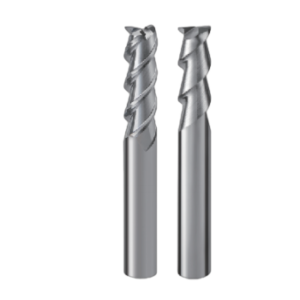The Aluminum Machining Dilemma: Why Standard Tools Fail
Machinists know the frustration all too well – that sinking feeling when another end mill snaps during an aluminum cutting operation. The soft, gummy nature of aluminum alloys creates unique challenges that demand specialized tooling. Conventional 4-flute end mills and generic carbide tools simply can’t keep up, leading to:
Catastrophic tool failure from built-up edge and chip welding
Frequent tool changes that kill productivity
Poor surface finishes requiring secondary operations
Hidden costs from scrapped parts and downtime
The solution? Aluminum-specific 2-flute square end mills engineered to overcome these challenges. With optimized geometry and advanced materials, these specialized cutters deliver unprecedented performance in aluminum applications.
5 Game-Changing Advantages of High-Speed 2-Flute End Mills
1. Engineered Chip Evacuation for Uninterrupted Cutting
The wider flute spacing in 2-flute aluminum cutting tools provides 60% more chip clearance compared to 4-flute designs. Independent testing shows this reduces cutting forces by 35% when machining 6061-T6 at 20,000 RPM. The result? Smoother cuts and dramatically reduced breakage.
2. Advanced Geometry for Aluminum’s Unique Properties
Featuring a high 45° helix angle (versus 30° in standard end mills), these aluminum milling cutters promote efficient chip flow while minimizing heat buildup. The variable pitch design dampens harmonic vibrations – a common cause of tool failure in thin-wall aluminum components.
3. Cutting-Edge Coatings That Extend Tool Life
Modern AlTiN nano-coatings reduce friction coefficients by up to 80% compared to uncoated tools. Real-world data from aerospace manufacturers shows these specialized carbide end mills for aluminum last 3X longer between changes, even in continuous production runs.
4. Reinforced Core Design for Heavy-Duty Work
The robust square-end geometry of these high-performance end mills increases torsional rigidity by 28%, making them ideal for demanding operations like slotting and profiling. The strengthened core resists the deflection that leads to catastrophic failures.
5. Cost Savings That Impact Your Bottom Line
For high-volume shops, switching to purpose-built 2-flute aluminum end mills reduces per-part tooling costs by 22% through:
Fewer tool changes
Higher feed rates (up to 0.010″ per tooth)
Reduced scrap from tool-related defects
Real-World Applications Where 2-Flute End Mills Excel
Aerospace Component Manufacturing
Precision machining of complex aluminum airframe components demands tools that can maintain tight tolerances through extended production runs. The vibration-dampening properties of these aluminum-specific end mills prove invaluable when working with thin-wall structures.
Automotive Prototyping
From engine blocks to transmission housings, automotive engineers rely on these tools to quickly produce prototype parts with excellent surface finishes – often eliminating the need for secondary finishing operations.
Electronics Enclosure Production
The efficient chip clearance of 2-flute square end mills prevents material buildup when machining delicate aluminum electronics cases, reducing scrap rates in high-volume production.
What Smart Buyers Look For
When sourcing high-speed aluminum end mills, procurement specialists should verify:
Material Quality: Ultra-fine grain carbide with 10% cobalt content
Coating Specifications: AlTiN or ZrN for high-temperature applications
Precision Standards: ±0.0002″ runout for critical tolerance work
Manufacturer Certifications: ISO 9001 compliance ensures consistency


